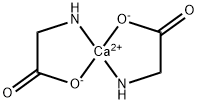In a study in humans to determine the absorption of calcium from calcium bis-glycinate in comparison to other sources of calcium, a group of adult women (aged from 20 to 40 years) with normal menstrual periods and no prior history of absorption disorders was selected. Most subjects were studied in the follicular phase of their menstrual cycles. The test subjects were given various forms of calcium (calcium bis-glycinate, calcium citrate malate, calcium carbonate, tricalcium phosphate, calcium citrate, hydroxyapatite, and calcium oxalate), which had been labelled with either 45Ca or 47Ca. The data show that the percentage absorption of calcium from Ca-bis-glycinate was 44. 0 ± 10.4 %, which is higher than the absorption of calcium from the other Ca-sources, which varied between 16.6 ± 9.0 % and 24.2 ± 4.9 %. A study conducted by Greger et al. showed similar bioavailability for several different calcium sources, including milk, dibasic calcium phosphate, oyster shell, calcium carbonate, calcium lactate, calcium bis-glycinate and dolomite.

